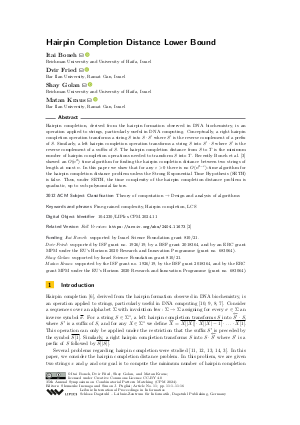Hairpin Completion Distance Lower Bound
Authors
Itai Boneh  ,
Dvir Fried
,
Dvir Fried  ,
Shay Golan
,
Shay Golan  ,
Matan Kraus
,
Matan Kraus 
-
Part of:
Volume:
35th Annual Symposium on Combinatorial Pattern Matching (CPM 2024)
Part of: Series: Leibniz International Proceedings in Informatics (LIPIcs)
Part of: Conference: Annual Symposium on Combinatorial Pattern Matching (CPM) - License:
 Creative Commons Attribution 4.0 International license
Creative Commons Attribution 4.0 International license
- Publication Date: 2024-06-18
File

PDF
LIPIcs.CPM.2024.11.pdf
- Filesize: 0.8 MB
- 16 pages
Document Identifiers
Related Versions
- Full Version https://arxiv.org/abs/2404.11673
Subject Classification
ACM Subject Classification
- Theory of computation → Design and analysis of algorithms
Keywords
- Fine-grained complexity
- Hairpin completion
- LCS
Metrics
- Access Statistics
-
Total Accesses (updated on a weekly basis)
0PDF Downloads0Metadata Views
Abstract
Hairpin completion, derived from the hairpin formation observed in DNA biochemistry, is an operation applied to strings, particularly useful in DNA computing. Conceptually, a right hairpin completion operation transforms a string S into S⋅ S' where S' is the reverse complement of a prefix of S. Similarly, a left hairpin completion operation transforms a string S into S'⋅ S where S' is the reverse complement of a suffix of S. The hairpin completion distance from S to T is the minimum number of hairpin completion operations needed to transform S into T. Recently Boneh et al. [Itai Boneh et al., 2023] showed an O(n²) time algorithm for finding the hairpin completion distance between two strings of length at most n. In this paper we show that for any ε > 0 there is no O(n^{2-ε})-time algorithm for the hairpin completion distance problem unless the Strong Exponential Time Hypothesis (SETH) is false. Thus, under SETH, the time complexity of the hairpin completion distance problem is quadratic, up to sub-polynomial factors.
Cite As Get BibTex
Itai Boneh, Dvir Fried, Shay Golan, and Matan Kraus. Hairpin Completion Distance Lower Bound. In 35th Annual Symposium on Combinatorial Pattern Matching (CPM 2024). Leibniz International Proceedings in Informatics (LIPIcs), Volume 296, pp. 11:1-11:16, Schloss Dagstuhl – Leibniz-Zentrum für Informatik (2024)
https://doi.org/10.4230/LIPIcs.CPM.2024.11
BibTex
@InProceedings{boneh_et_al:LIPIcs.CPM.2024.11,
author = {Boneh, Itai and Fried, Dvir and Golan, Shay and Kraus, Matan},
title = {{Hairpin Completion Distance Lower Bound}},
booktitle = {35th Annual Symposium on Combinatorial Pattern Matching (CPM 2024)},
pages = {11:1--11:16},
series = {Leibniz International Proceedings in Informatics (LIPIcs)},
ISBN = {978-3-95977-326-3},
ISSN = {1868-8969},
year = {2024},
volume = {296},
editor = {Inenaga, Shunsuke and Puglisi, Simon J.},
publisher = {Schloss Dagstuhl -- Leibniz-Zentrum f{\"u}r Informatik},
address = {Dagstuhl, Germany},
URL = {https://drops.dagstuhl.de/entities/document/10.4230/LIPIcs.CPM.2024.11},
URN = {urn:nbn:de:0030-drops-201215},
doi = {10.4230/LIPIcs.CPM.2024.11},
annote = {Keywords: Fine-grained complexity, Hairpin completion, LCS}
}
Author Details
Funding
- Boneh, Itai: supported by Israel Science Foundation grant 810/21.
- Fried, Dvir: supported by ISF grant no. 1926/19, by a BSF grant 2018364, and by an ERC grant MPM under the EU’s Horizon 2020 Research and Innovation Programme (grant no. 683064).
- Golan, Shay: supported by Israel Science Foundation grant 810/21.
- Kraus, Matan: supported by the ISF grant no. 1926/19, by the BSF grant 2018364, and by the ERC grant MPM under the EU’s Horizon 2020 Research and Innovation Programme (grant no. 683064).
References
- Amir Abboud, Arturs Backurs, and Virginia Vassilevska Williams. Tight hardness results for LCS and other sequence similarity measures. In Venkatesan Guruswami, editor, IEEE 56th Annual Symposium on Foundations of Computer Science, FOCS 2015, Berkeley, CA, USA, 17-20 October, 2015, pages 59-78. IEEE Computer Society, 2015. URL: https://doi.org/10.1109/FOCS.2015.14.
- Itai Boneh, Dvir Fried, Shay Golan, and Matan Kraus. Hairpin completion distance lower bound, 2024. URL: https://arxiv.org/abs/2404.11673.
- Itai Boneh, Dvir Fried, Adrian Miclaus, and Alexandru Popa. Faster algorithms for computing the hairpin completion distance and minimum ancestor. In Laurent Bulteau and Zsuzsanna Lipták, editors, 34th Annual Symposium on Combinatorial Pattern Matching, CPM 2023, June 26-28, 2023, Marne-la-Vallée, France, volume 259 of LIPIcs, pages 5:1-5:18. Schloss Dagstuhl - Leibniz-Zentrum für Informatik, 2023. URL: https://doi.org/10.4230/LIPICS.CPM.2023.5.
-
Karl Bringman and Marvin Künnemann. Multivariate fine-grained complexity of longest common subsequence. In Proceedings of the Twenty-Ninth Annual ACM-SIAM Symposium on Discrete Algorithms, pages 1216-1235. SIAM, 2018.

-
Chris Calabro, Russell Impagliazzo, and Ramamohan Paturi. The complexity of satisfiability of small depth circuits. In Jianer Chen and Fedor V. Fomin, editors, Parameterized and Exact Computation, pages 75-85, Berlin, Heidelberg, 2009. Springer Berlin Heidelberg.

-
Daniela Cheptea, Carlos Martin-Vide, and Victor Mitrana. A new operation on words suggested by DNA biochemistry: Hairpin completion. Transgressive Computing, January 2006.

-
Lila Kari, Stavros Konstantinidis, Elena Losseva, Petr Sosík, and Gabriel Thierrin. Hairpin structures in DNA words. In Alessandra Carbone and Niles A. Pierce, editors, DNA Computing, pages 158-170, Berlin, Heidelberg, 2006. Springer Berlin Heidelberg.

-
Lila Kari, Stavros Konstantinidis, Petr Sosík, and Gabriel Thierrin. On hairpin-free words and languages. In Clelia De Felice and Antonio Restivo, editors, Developments in Language Theory, pages 296-307, Berlin, Heidelberg, 2005. Springer Berlin Heidelberg.

-
Lila Kari, Elena Losseva, Stavros Konstantinidis, Petr Sosík, and Gabriel Thierrin. A formal language analysis of DNA hairpin structures. Fundamenta Informaticae, 71(4):453-475, 2006.

-
Lila Kari, Kalpana Mahalingam, and Gabriel Thierrin. The syntactic monoid of hairpin-free languages. Acta Informatica, 44(3):153-166, June 2007.

-
Florin Manea. A series of algorithmic results related to the iterated hairpin completion. Theoretical Computer Science, 411(48):4162-4178, 2010.

- Florin Manea, Carlos Martín-Vide, and Victor Mitrana. On some algorithmic problems regarding the hairpin completion. Discret. Appl. Math., 157(9):2143-2152, 2009. URL: https://doi.org/10.1016/J.DAM.2007.09.022.
-
Florin Manea, Carlos Martín-Vide, and Victor Mitrana. Hairpin lengthening. In Fernando Ferreira, Benedikt Löwe, Elvira Mayordomo, and Luís Mendes Gomes, editors, Programs, Proofs, Processes, pages 296-306, Berlin, Heidelberg, 2010. Springer Berlin Heidelberg.

-
Florin Manea, Carlos Martín-Vide, and Victor Mitrana. On some algorithmic problems regarding the hairpin completion. Discrete Applied Mathematics, 157(9):2143-2152, 2009. Optimal Discrete Structures and Algorithms.

